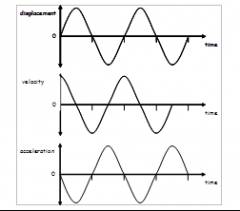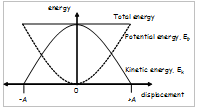![]()
![]()
![]()
Use LEFT and RIGHT arrow keys to navigate between flashcards;
Use UP and DOWN arrow keys to flip the card;
H to show hint;
A reads text to speech;
37 Cards in this Set
- Front
- Back
|
Capacitance definition
|
charge stored per unit potential difference
|
|
|
Capacitance graphs: Q against V
(gradient and area) |
Gradient is capacitance : C=Q/V
Area under is energy stored by capacitor |
|
|
Capacitance Graphs: V against Q
(gradient and area) |
Gradient is 1/capacitance
Area under is energy stored by capacitor |
|
|
Derivation of E=½QV
|
(change in W) = V x (change in Q) explained (1)
energy stored = total work done in charging = charge x average voltage (1) energy stored = work done (= ½QV) (1) |
|
|
Graph description of Energy stored against voltage
|
Energy = ½CV^2
Exponential curve upwards Energy Proportional to V^2 Straight diagonal upwards, through origin |
|
|
Time Constant Definition
|
Time taken for the voltage (or charge or current) to fall to 1/e of its original value
|
|
|
Finding time constant from a graph of Potential Difference (V) against time (t) [STEP 1]
|
[STEP 1] Calculate 1/e of initial Voltage, V
|
|
|
Finding time constant from a graph of Potential Difference (V) against time (t) [STEP 2]
|
[STEP 2] Locate value on graph, time taken is Time constant
|
|
|
Re-arrange V=Vo e^-t/RC
|
[1] Divide both by Vo | V/Vo = e^-t/RC
[2] Log (ln) both sides | ln(V/Vo) = -t/RC |
|
|
Finding time constant from a graph of ln (v) against time. [Given that ln(V/Vo) = -t/RC]
|
[3] Break up the log | ln(V) - ln(Vo) = -t/RC
[4] Into form like y=mx+c | ln(V) = {-1/RC}{t}+{ln(Vo)} |
|
|
Finding time constant from a graph of ln (v) against time. [In form y=mx+c || ln(V) = {-1/RC}{t}+{ln(Vo)} ]
|
Gradient is -t/RC & Intercept is ln(Vo)
Time Constant (RC) = 1/Gradient |
|
|
Newton’s 1st Law
|
An object remains at rest or in uniform motion unless acted on by a force
|
|
|
Newton’s 2nd Law
|
The rate of change of momentum of an object is proportional to the resultant force on it
|
|
|
Newton’s 3rd Law
|
When two objects interact they exert equal and opposite forces on each other
|
|
|
Force (in terms of momentum change)
|
Force = rate of change of momentum. VECTOR
|
|
|
Units of momentum
|
kgms^-1
|
|
|
Units of rate of change of momentum
|
kgms^-2
|
|
|
Impulse, I
|
Force x time for which the force acts (Ft)
Hence Impulse = change of momentum. VECTOR |
|
|
Units of Impulse, I
|
Ns or kgms-1
|
|
|
Graphical representations of charging a capacitor against time
|

|
|
|
Graphical representations of discharging a capacitor against time
|

|
|
|
Area under a graph of force against time
|
change in momentum (p) or Impulse I
|
|
|
Principle of conservation of linear momentum definition
|
In a collision (or explosion) the total momentum before equals the total momentum after, providing no external forces are acting.
|
|
|
Elastic collision definition
|
A collision where kinetic energy is conserved
|
|
|
Inelastic collision definition
|
A collision where kinetic energy is not conserved
Note: TOTAL Energy is still conserved. |
|
|
Angular speed, 'w'
|
angle turned through per second (SCALAR)
|
|
|
Units of Angular speed 'w'
|
rad s^-1
|
|
|
Angular speed of earth
|

|
|
|
Centripetal Force
|
RESULTANT force acting towards the centre of the circular path.
|
|
|
Conditions for SHM (simple harmonic motion)
|
1. Acceleration is proportional to displacement
2. Acceleration is in the opposite direction to displacement OR acceleration always acts towards the equilibrium position. |
|

|
1. acceleration is always proportional to displacement (a proportional to x) and hence a = kx, where k is a constant (2[pi]f)^2
|
|
|
Graph of acceleration against displacement
|

|
|
|
Graph of displacement against time
|
Gradient of a displacement against time graph is VELOCITY
|
|
|
Graphical representations linking x (displacement), v (velocity), a (acceleration) and t (time)
|

|
|
|
Conditions for the time period equation of a pendulum
|
Time period equation for a pendulum id only true for oscillations with a SMALL amplitude, which includes angular displacements less than 10 degrees.
|
|
|
Dependence of time period on amplitude of an oscillation
|
The time period of an oscillation in SHM is INDEPENDANT of the amplitude.
|
|
|
Variation of Potential energy and Kinetic energy with displacement
|

|

